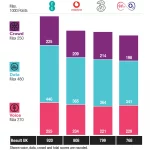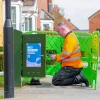53% of UK Mobile Users See Average Downloads Below 30Mbps

New data from mobile benchmarking firm Opensignal has revealed that 53.3% of UK Smartphone users achieve average mobile broadband download speeds below 30Mbps (sub-“superfast” level), while 14% suffer sub-10Mbps downloads and 4.7% of users spend over 5% of their time with no mobile signal at all.
The analysis, which is based off crowdsourced data gathered from users on hundreds of thousands of devices (Smartphones etc.) between 1st December 2022 and 28th February 2023, helps to highlight the challenges of using mobile technology (4G, 5G etc.) to fill in gaps in fixed broadband services and offer a “superfast” experience (defined by the EU and UK as 30Mbps+).
Large differences were also found in the proportion of users with poor download speeds. Out of the 12 UK cities analysed, there are 5 where the proportion of our users that experience average mobile speeds below 10Mbps is above the national average of 14.3% of users – Bristol, Glasgow, Edinburgh, Newcastle and Hull.
Advertisement
Looking at the other end of the scale, where proportionally less users experience these slow speeds than the national average, only 6.3% of users in Sheffield have these very slow speeds, and it is followed by Nottingham (8.8%) and Birmingham (8.8%). London is mid-table with 12.1%.

Mark is a professional technology writer, IT consultant and computer engineer from Dorset (England), he also founded ISPreview in 1999 and enjoys analysing the latest telecoms and broadband developments. Find me on X (Twitter), Mastodon, Facebook, BlueSky, Threads.net and Linkedin.
« Ofcom to Stop Publishing UK Home Broadband ISP Speeds Study
Connect Fibre Launch Try Before You Buy on FTTP Broadband »























































Doesn’t surprise me much. UK carriers (but in general I always noticed this across many carriers in the world) don’t have the needed density of sites that should have and the numbers of layers on air needed to give such speeds consistently.
So more masts and with more layers would be needed.
addendum: in the world as compared to my native country Italy, where for a specific and peculiar reason density of masts is much, much higher.
The UK’s persistent nimbyism and mindless obsession with preserving the past ensure that we’ll never see the requisite density of masts to make much improvement. It’s either too costly, simply prohibited, or blocked by tin-foil hatters. That’s also why our roads are poor, and our railways worse. Not to mention that the mobile networks already charge as much as they can, so why invest a whole lot more when (from their perspective) the situation is entirely tolerable and the investment won’t earn them any more money?
There was briefly some hope that lamp posts could carry 5G masts, which if widely adopted would be revolutionary, but that seems to have largely fallen to bits because government left it to local authorities, rather than imposing a PIA obligation on them and a firm infrastructure sharing obligation on the mast owners. As a result there’s endless wrangling about access rights, payments, excuses by all parties as to why it is impossible or difficult, along with far too many different parties involved.
Well said Andrew G
In my area, speeds vary from 5mbps with Three to 250 on EE. I wonder how big a factor in these downtime/slow numbers comes down to the network in the users area being poor.
Not surprised Edinburgh is top of the list mostly around leith and Newhaven there is next to no signal from EE other parts of the city is quite good for signal
I can quite believe it, for years I experience low download speeds with 3 typically 2mbps. In the end I switched to EE and now I get a minimum of 60mbps most of the time, rising to over 100mbps at night. The 3 network has a lot of users, many belong to Smarty which I blamed for the pathetically low speeds. Maybe it would be more informative if they checked to see which network was giving these low speeds because take 3 out of the equation and those figures will change dramatically.
The government, local councils, network operators, Ofcom and regulators will pay a fat price for their laid back penny pinching complacency.
I’m one of those 53%.
My mobile speedtests at home where I spend most of my time are 3mbps indoors, 14mbps outside and around the neighborhood.
On O2 and various O2 based MVNOs.
Vodafone is s little better but I haven’t measured it.
The biggest issue is capacity. In a lot of population centres you can have a full strength 4g or 5g signal but performance is woeful due to the amount of users you’re sharing the bandwidth from that cell site with.
And the MNOs just don’t seem to have the appetite to invest in 5g stand alone via small cells. They are are all just trying to secure more traditional macro sites. Something which just doesn’t scale well with 5g or the fact that more and more tower blocks are springing up, so it’s becoming even more challenging to serve users at street level all around and in between tall buildings as well as users inside those buildings.
Totally agree Mark. It’s something that will never scale well, which highlights clearly that it is all well and good having “The next great thing” (pretend 5G, NSA (real) 5G, 6G etc), but it won’t be any quicker in most places when the masts don’t have the bandwidth to supply the population of that area.
There isn’t a carrier out there who gives a flying fig if their masts are totally saturated and over contended.
Its high time there were minimum speed service level agreements mandated by OFCOM. Then again expecting OFCOM to do anything for consumers these days is a big stretch, isn’t it?
I’d argue these figures are inflated. I never see more than 10Mb in my town on the south coast. Barely see much better in the local city either (although it is a little better).